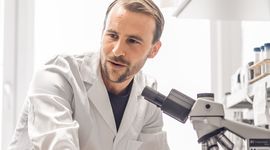A topical therapeutic for the treatment of RDEB and DDEB wounds
New scientific publication with EB House contribution
Underlying cause of dystrophic EB (DEB) are recessively (RDEB) or dominantly (DDEB) inherited mutations in the collagen 7 gene, which either lead to the production of a defective collagen 7 protein or its complete absence in the skin. Consequently, the two skin layers separate, resulting in skin blistering often associated with painful wounding. There is a clear medical need to develop therapeutic approaches for these patients. While promising strategies are currently underway for severe forms of RDEB, therapy development for the often milder symptoms of DDEB patients has not yet been in the focus so far.
In an international study, published in the Journal of Investigative Dermatology, EB House researchers contributed to the exploration of the exon skipping technology as a promising treatment option for both, RDEB and DDEB wounds. Exons are DNA pieces that, when linked together, form a gene transcript, which contains the genetic code for a protein. Exons are separated by introns that do not contain protein information, and are removed when a protein is produced. Exon skipping uses a designed repair molecule (ASO), which is delivered into the skin cells, where it specifically blocks the mutated exon, which leads to its absence in the genetic code.
In this study, the scientists have designed an ASO named QR-313 that removes one specific exon of the collagen 7 gene, harbouring a mutation recurrent in DDEB and RDEB patients. The resulting shortened gene transcript should be able to produce a partially functional collagen 7 protein, sufficient for the cohesion of the skin layers.
Exon skipping does not permanently correct the defect and therefore needs to be applied repeatedly. Injections of drugs into inflamed skin are associated with extreme pain and represent thus an unfavourable treatment for EB patients. In this study, a hydrogel for pain reduced topical delivery of the ASO into skin cells of wounded skin areas was developed.
The approach was tested in artificial human skin generated from RDEB and DDEB cells respectively. The QR-313 hydrogel was applied onto a created wound bed two to three times a week for several weeks. Analyses showed an increased skin stability in the skin treated with QR-313 compared to placebo treated (hydrogel without QR-313) skin. The analyses also showed that small amounts of a partially functional collagen 7 protein are sufficient to significantly improve skin attachment.
These results support a clinical application of QR-313 as a topical therapeutic for the treatment of wounds in RDEB and DDEB patients.
To access the article please click here
